This was not the first time Ramsey had posed with a shark. In fact, she does it often. Her goal? To show that sharks are not the monsters they are often made out to be, and to inspire others to help protect them.
And sharks do need our protection—urgently. Each year, between 70 and 100 million sharks are killed by humans. Some die when they get tangled in fishing gear, but most are hunted for their fins. Shark fin soup is a prized dish in many countries, where some people believe shark fins have healing powers.
Now, many species of sharks are nearly extinct. Others, including the great white, are threatened. This is catastrophic for sharks, the oceans, and humans. All of us on Earth—humans, animals, plants—are connected. If something happens to one species, it can trigger a chain reaction that affects many others.
For example, if great white sharks disappeared, the number of seals would skyrocket because great whites eat seals. All those seals would gobble up small fish until there weren’t many left. What would happen to the birds that survive by eating those smaller fish? What about the humans who depend on fishing for food or jobs? Without sharks, many creatures would struggle to survive.

